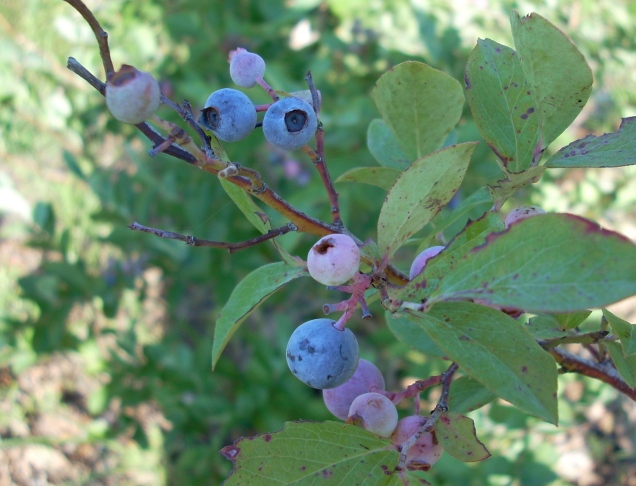To produce optimum fruit yield and quality, most deciduous fruit cultivars require exposure to temperatures between 45ºF and 32˚F during the winter. This is known as chill hours. With insufficient chilling, plants do not flower and leaf out satisfactorily during the spring. Growth can be weak and erratic. Low-chill cultivars of blueberries are necessary for southern growers.
Two types of blueberries grow well in Texas, rabbiteye (Vaccinium virgatum) and southern highbush (interspecific hybrids of V. darrowii, V. virgatum, and V. corymbosum). The rabbit eye varieties need between 350 to 650 chill hours and the southern high bush need between 150 to 400 hours.
Both rabbiteye and southern highbush thrive in acidic soils, which contain more organic matter than is usually found in our soils. If mulched, rabbiteye blueberries will usually grow satisfactorily on soils with 1% organic matter, but they perform better with soils that have 2–3% organic matter. Southern highbush cultivars are not recommended for soils with less than 3% organic matter. Consequently, most gardeners will have to supply soil amendments and mulches. Peat moss is commonly used to increase soil organic matter and add acidity in blueberry plantings.
Blueberries need a fungal soil and fungi thrive in acidic soils with a ph of 4.5-5.5.
If you are installing a commercial plot you should get a soil report follow recommendations. A commercial operation should only be set up in areas with naturally acidic soils. A soil report would also benefit the home gardener. In absence of a soil report and the recommendations that accompany it follow these ideas.
Dig your hole about 3 foot in diameter and about 10″ deep. Replace the soil with compost and peat moss filling the the hole and building a mound about 6″ high. Mix two cups of rock phosphate in the soil. If your ph is 7.0 (not unusual for the black gumbo soils) mix one cup of sulfur per plant in the soil, cutting that in half for soils of 6.5 ph. The soil ph will not change quickly and we are wanting to get to a ph of 4.5 to 5.5. It would be best to apply the organic matter and sulfur a year before planting if you can be that patient. If you cannot wait a year, make the amendments now and wait one month or more to plant the blueberry. Soil temperature needs to be over 55˚ for the biological activity to happen.
Plant the blueberry at the same height or 1” higher than it was in the pot–never let it sink lower. Make sure the area drains well. Blueberries need good drainage. Blueberries have very shallow root systems. Blueberries grow well in shade but will not flower and fruit without sufficient sun. Set them in a site where they will get at least 5 hours of spring sun per day. Rabbiteye berries should be planted five to seven feet apart. Southern highbush can be planted 4-5feet apart. Of course, you can plant closer for a hedgerow effect, but it will be difficult to reach all the berries. A mature rabbiteye blueberry plant (7 or 8 years old) can reach heights of 15 feet and be 10 feet wide. Most southern highbush will get about 7 feet tall. Mulch the berries with 3 inches of mulch out 2 feet from the trunk but not touching the trunk. Maintain mulch past the drip line as the plant grows. This is for maintaining moisture, moderating soil temperature, adding organic matter and weed control. Weed control is extremely important for young plant establishment because blueberries are shallow-rooted plants that compete poorly with weeds for water, soil oxygen and nutrients. Hand weed only. Do not use a hoe. Use of pine bark mulch and pine needle mulch will also provide additional acidity.
Due to their shallow roots they must be watered often, but should never stand in water. In the heat of the summer, daily watering is necessary so an automatic system works well. Blueberry plants do not produce root hairs necessary for the uptake of water and nutrients. Instead, the plants are entirely dependent on symbiotic relationship with mycorrhizal fungi. The plant provides nourishment for the fungi and the fungi act as root hairs for the plant. For this reason I prefer to avoid chlorinated water.
Blueberries do not require pruning, but remove weak growth and dead branches. During the first growing season, remove all flowers before fruit set occurs. This will prevent fruiting during the first year and promote strong vegetative and root growth and good plant establishment. This is especially important with some southern highbush cultivars that flower heavily as young plants.
If you prune them for size, do that in the summer after fruiting is complete. I fertilize with micro life fertilizer in March, June and September. Add to that a spray of compost tea in March, May, July, and September and maintain sufficient mulch around the plant. Coffee grounds are good to add to the mulch.
Blueberries, especially the smaller southern highbush blueberries, grow well in containers. Sunshine blue is an especially small variety. Plant in a wide pot, at least 10 gallons and 18” in diameter. They only need 10″ of soil depth. Increase to a half barrel size in two years.
Different varieties fruit at different times with harvest season extending April through June. Fruit forms on the top of one year old branches. Rabbiteye blueberries require two varieties to pollinate and southern highbush berries produce better with cross pollination.
